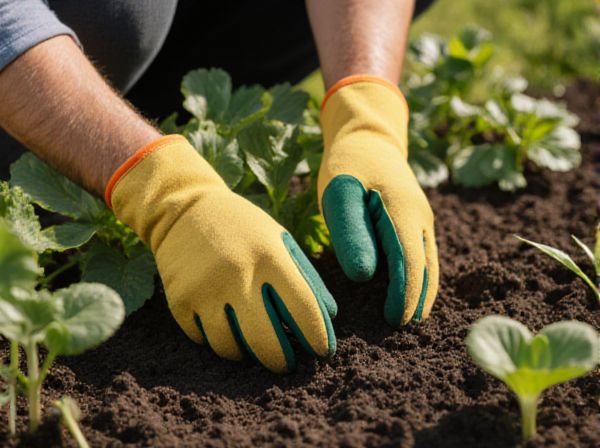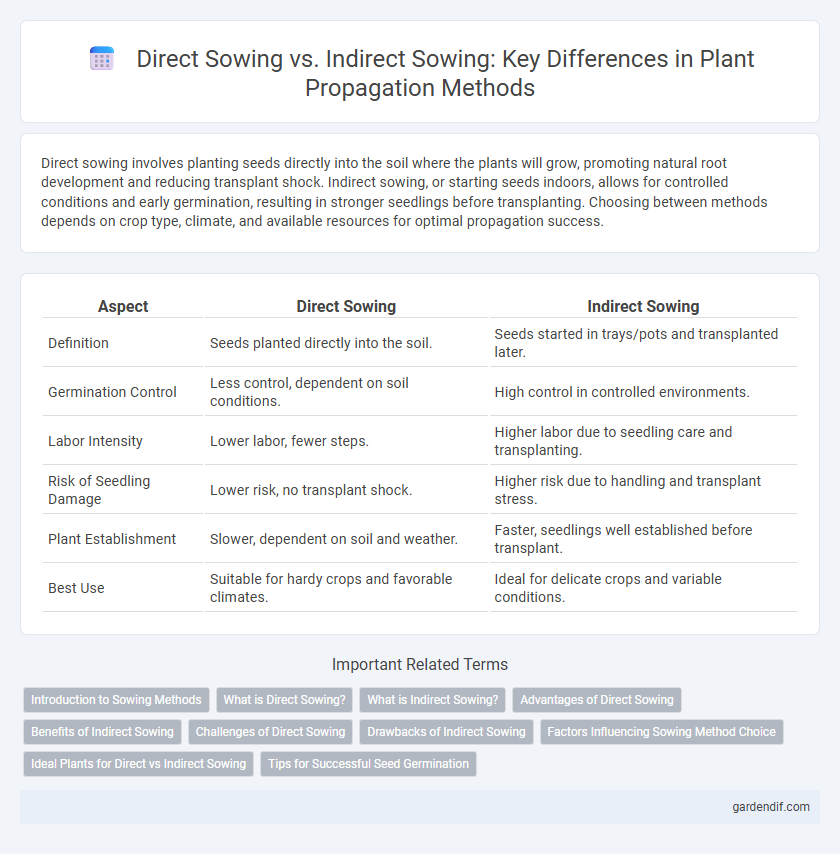
Direct sowing vs indirect sowing Illustration
Direct sowing involves planting seeds directly into the soil where the plants will grow, promoting natural root development and reducing transplant shock. Indirect sowing, or starting seeds indoors, allows for controlled conditions and early germination, resulting in stronger seedlings before transplanting. Choosing between methods depends on crop type, climate, and available resources for optimal propagation success.
Table of Comparison
| Aspect | Direct Sowing | Indirect Sowing |
|---|---|---|
| Definition | Seeds planted directly into the soil. | Seeds started in trays/pots and transplanted later. |
| Germination Control | Less control, dependent on soil conditions. | High control in controlled environments. |
| Labor Intensity | Lower labor, fewer steps. | Higher labor due to seedling care and transplanting. |
| Risk of Seedling Damage | Lower risk, no transplant shock. | Higher risk due to handling and transplant stress. |
| Plant Establishment | Slower, dependent on soil and weather. | Faster, seedlings well established before transplant. |
| Best Use | Suitable for hardy crops and favorable climates. | Ideal for delicate crops and variable conditions. |
Introduction to Sowing Methods
Direct sowing involves planting seeds directly into the soil where the plants will mature, ensuring a more natural root development and reducing transplant shock. Indirect sowing starts seeds in controlled environments like seed trays or nurseries, allowing for better management of germination conditions and early growth before transplantation. Both methods offer distinct advantages depending on crop type, climate, and resource availability, influencing overall propagation success.
What is Direct Sowing?
Direct sowing involves planting seeds directly into the soil where the plants will mature, bypassing the transplanting stage used in indirect sowing. This method reduces root disturbance, minimizes labor, and is suited for crops like carrots, beans, and corn that thrive when seeded straight into the field. Optimal soil temperature and moisture at planting significantly enhance germination rates in direct sowing.
What is Indirect Sowing?
Indirect sowing involves starting seeds in a controlled environment such as seed trays or nurseries before transplanting seedlings to the field, allowing better management of germination conditions and early growth. This method increases the survival rate of seedlings by protecting them from adverse weather and pests during their most vulnerable stages. Indirect sowing is particularly advantageous for crops requiring a longer growing season or delicate handling during initial growth phases.
Advantages of Direct Sowing
Direct sowing enhances seedling establishment by minimizing root disturbance, promoting stronger root systems and faster growth. This method reduces labor and costs associated with transplanting seedlings, making it economically efficient for large-scale crops. Furthermore, direct sowing improves soil structure by avoiding repeated digging, which supports better water retention and nutrient availability.
Benefits of Indirect Sowing
Indirect sowing promotes stronger seedling development by allowing controlled nursery conditions that protect young plants from harsh environmental stresses. This method enhances root establishment and increases survival rates during transplantation, resulting in healthier crops and higher yields. Furthermore, indirect sowing enables better pest and disease management through early detection and treatment in a confined setting.
Challenges of Direct Sowing
Direct sowing faces challenges such as inconsistent seed germination due to soil moisture variability and exposure to pests and diseases. Weed competition often reduces seedling establishment, impacting overall crop yield. Moreover, direct sowing requires precise soil preparation and seed placement to ensure uniform growth and minimize losses.
Drawbacks of Indirect Sowing
Indirect sowing often results in increased labor and higher costs due to the need for transplanting seedlings from nurseries to fields. This method can lead to transplant shock, reducing plant vigor and yield potential compared to direct sowing. Additionally, indirect sowing requires more time for seedling preparation, delaying the overall crop cycle and potentially affecting timely harvests.
Factors Influencing Sowing Method Choice
Soil type, climate conditions, and crop species significantly influence the choice between direct and indirect sowing methods. Direct sowing suits well-drained soils and crops with high seed vigor, while indirect sowing is preferred for sensitive seedlings requiring controlled environments. Availability of resources such as labor, water, and nursery facilities also affects the selection of the appropriate propagation technique.
Ideal Plants for Direct vs Indirect Sowing
Ideal plants for direct sowing include hardy vegetables like carrots, radishes, and beans, which thrive when planted directly into the garden soil. Indirect sowing is preferable for delicate or slow-germinating seeds such as tomatoes, peppers, and eggplants, as they benefit from controlled indoor environments before transplanting. This method ensures better seedling survival rates and stronger young plants for transplanting.
Tips for Successful Seed Germination
Ensure soil temperature is optimal, typically between 65-75degF, for direct sowing to promote faster seed germination. In indirect sowing, maintain consistent moisture and warmth in seed trays using humidity domes or heat mats to enhance seedling survival rates. Use high-quality, disease-free seeds and thin seedlings to prevent overcrowding and improve airflow for robust growth.
Direct sowing vs indirect sowing Infographic

 gardendif.com
gardendif.com